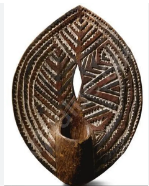The Silent Revolution of Robotics and Bionics Inspired by African Folding of Structures and Clothing
The
Silent Revolution of Robotics and Bionics Inspired by African Folding of
Structures and Clothing
In early traditions, our ancestors created structures imbued
with an important wisdom that we must remember: their designs mimicked natural
patterns. The curvatures and designs enabled these structures to be incredibly
strong. Research into these fields of design, which may seem simple, holds the
potential to unlock the future of robust, supportive bionic structures,
machinery, and survival structures for interplanetary colonization, ensuring
human sustainability and survival.
One notable example is the shield design, inspired by animal
skin and the natural curves of these shields. These shapes provide remarkable
strength. In my research on bionics, I have explored various folding
techniques, demonstrating that strong structures rely heavily on the principles
of folding. The emphasis on arts and crafts in CBC (Competency-Based
Curriculum) learning aligns with this concept. The practice of folding and
creating diverse designs is crucial for training today’s scientists and those
of the future.
Folding is a survival mechanism seen in both animals and
plants on this planet. For instance, armadillos fold into a ball to protect
themselves from predators, and certain plants fold their leaves to conserve
water and reduce exposure to harsh sunlight. This ancient art and craft are
integral to modern technology and must be advanced and improved through better
training.
I recently simulated a strong wheel by simply folding a
piece of paper, creating a spring-like structure capable of supporting heavy
weight. This demonstrates the potential of folding techniques in developing
resilient and efficient bionic and robotic systems. Embracing these traditional
techniques can lead to groundbreaking advancements in technology, bridging the
gap between ancient wisdom and modern innovation.




Comments
Post a Comment